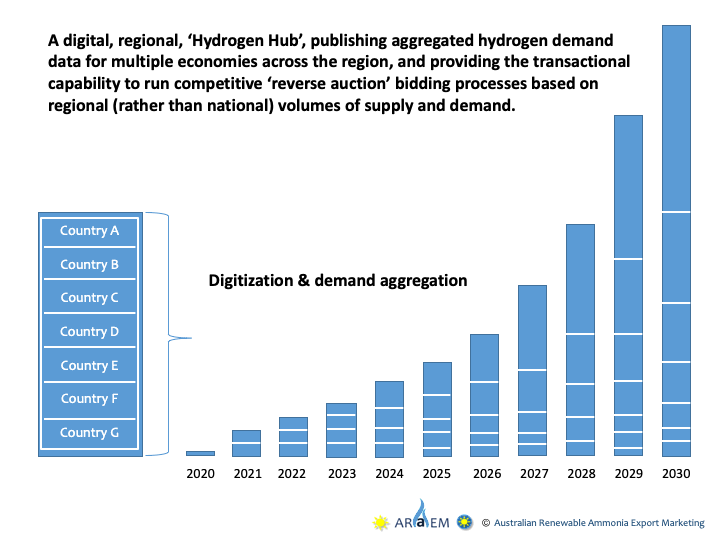Solar fuels could be Australia's biggest energy export

Australian developers are hoping to tap into the voracious demand for clean energy from the big north Asian economies, and create a “solar fuels” export industry at a scale many would have thought unimaginable.
Proponents such as Renewable Hydrogen’s Andrew Want are talking of the prospect of developing massive solar arrays in the Australian outback at a scale of “multiple tens” of gigawatts.
“This is a great opportunity to create a solar industry which is not limited to the scale of our electricity network,” Want tells RenewEconomy at the sidelines of the 6th World Hydrogen Technologies Congress in Sydney.
“This plan is bolted on to the prospects of the biggest economic growth region in the world.”
As RenewEconomy reported on Wednesday, there is a big push in Australia to tap into Japan’s emerging “hydrogen” economy, and use Australia’s rich solar and wind resources to provide clean fuels to Japan and other countries.
Professor Ross Garnut and the Clean Energy Finance Corporation chief executive Oliver Yates say this could create an export industry that could rival coal and gas.
Japan is hungry for hydrogen and clean liquid fuels because it relies so heavily on imported fuels – now entirely coal, oil and gas – but knows it needs to rapidly decarbonise.
It believes the best option for a country with limited renewable energy resources – and a nuclear strategy stranded by the Fukushima disaster – is hydrogen.
It has set in motion a “hydrogen plan” that includes fuel cells in homes and buildings, a refueling network for hydrogen fuel cell vehicles, and then for large-scale power plants.
But as we noted on Wednesday, while the likes of Garnaut, Yates and others involved in the emerging hydrogen industry in Australia see this as a way to unlock Australia’s renewable energy resources, some Japanese industrials seem more focused on using fossil fuel as feedstock, particularly cheap brown coal from Victoria.
There is a belief, though, that when costs for carbon capture and storage are included, and a strong signal for clean energy emerges from the climate conference in Paris, then renewables will be the most logical power source.
Want and his associates – including some big corporate names from Europe and Asia – are working on a plan to begin exports of solar fuels by using electrolysis and existing infrastructure for ammonia exports to test the Japanese market.
They are planning a small MW-scale pilot plant near Karratha in the Pilbara, not far from the country’s biggest ammonia plant, which would generate electricity from a solar PV plant, and add water for electrolysis, which separates the hydrogen from the oxygen.
If this initial project is successful, it would be followed by a massive solar PV plant of around 100MW to 400MW.
It would then be an industry that Want says could be in the multiple tens of gigawatts, and use a combination of solar PV and solar towers and storage. (Want is also a director of solar tower developer Vast Solar, which has a demonstration plant in western NSW).
To put this into some perspective, the Pilbara has some of the world’s best solar resources, and a land area of more than half a million square kilometres – one third bigger than all of Japan. And it has major LNG infrastructure.
“We have energy-intensive economies immediately to our north, including Japan and Korea, which are struggling to find a way to decarbonise their industry,” Want says.
“This is massive growth opportunity. Australia has huge solar resources in the Pilbara, western WA, Queensland and South Australia. We have also got wind and tidal.
“Ten years ago – this idea was just not feasible. But there has been a big fall in the cost of solar technology, and in electrolysis, and there has never been a stronger industrial imperative to improve cost and efficiency.”
Want says Europe has recognised that the way to store energy for industrial scale use is through hydrogen, and Japan has come to the same conclusion.
Right now, almost all of hydrogen currently made comes from fossil fuel feed stock, with just 4 per cent by electrolysis converging on same technologies.
Want says Japan’s hydrogen plan still assumes reliance on gas and coal for hydrogen production – but Australian promoters, taken aback by the scale of ambition from Kawasaki to use brown coal from Victoria as feedstock – are trying to talk them round to renewables.
“We have been constrained by what we could do within the local power system,” Want says. “But if you look at our trade relationships, and the need to decarbonise the global economy, that is where Australia can play a serious role.”
Financing projects at such a scale, once the concept is demonstrated, should not be a problem, given the massive shift of global funds from fossil fuels into clean energy, particularly into climate and green bonds
Want says a pilot plant could begin construction in 2016, and be in operation by 2018.
The creation of a solar fuels export industry would also lead to lower cost renewable energy generation for domestic use, as well as industrial gases. This, as Garnaut points out, could make Australia a natural site for clean energy-intensive industrial activity.
“This is not a five-year vision, it is a 20,30, 50 year vision,” Want says. “That is the timeframe that we saw for the development of the Pilbara iron ore reserves.
“If renewable hydrogen production can get down the cost curve and be of scale, we can remodel energy systems around hydrogen,” Want says.
http://reneweconomy.com.au/solar-fuels-could-be-australias-biggest-energy-export-59042/




